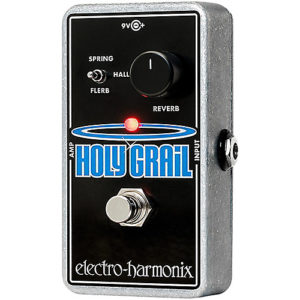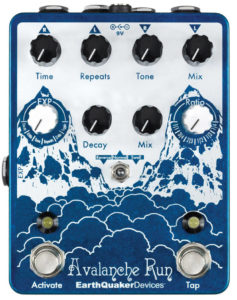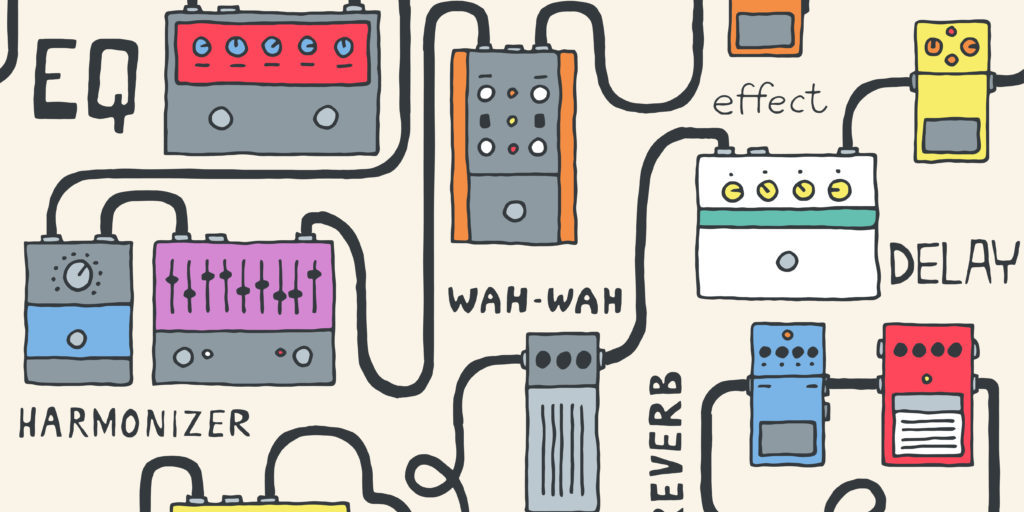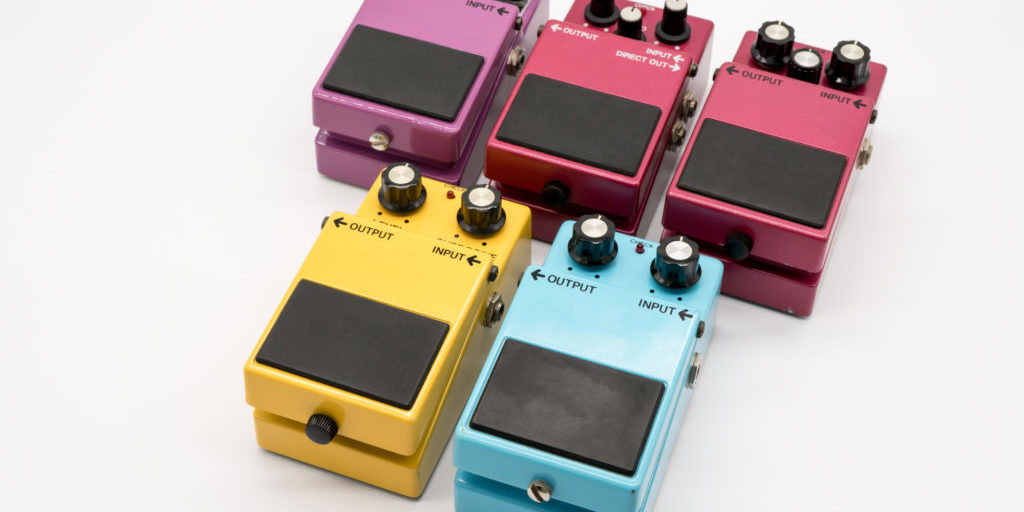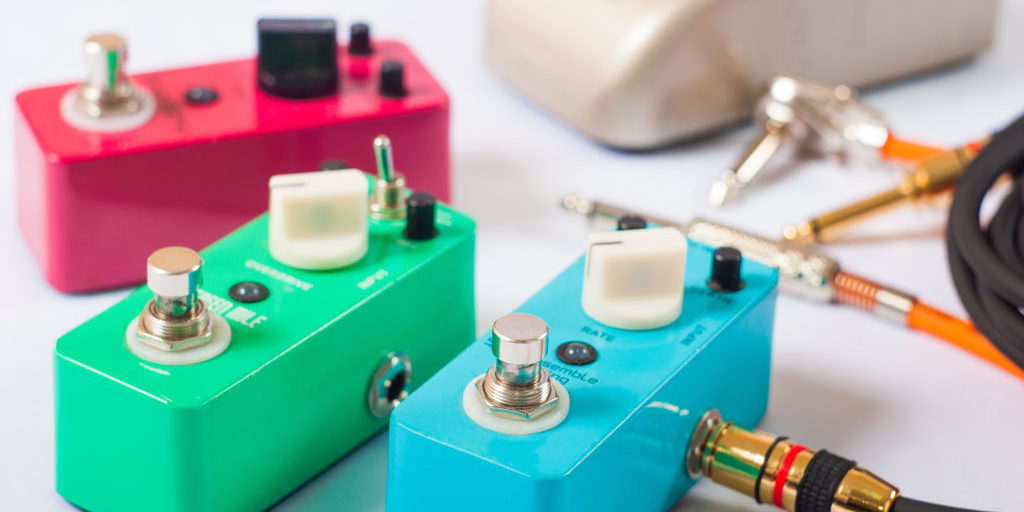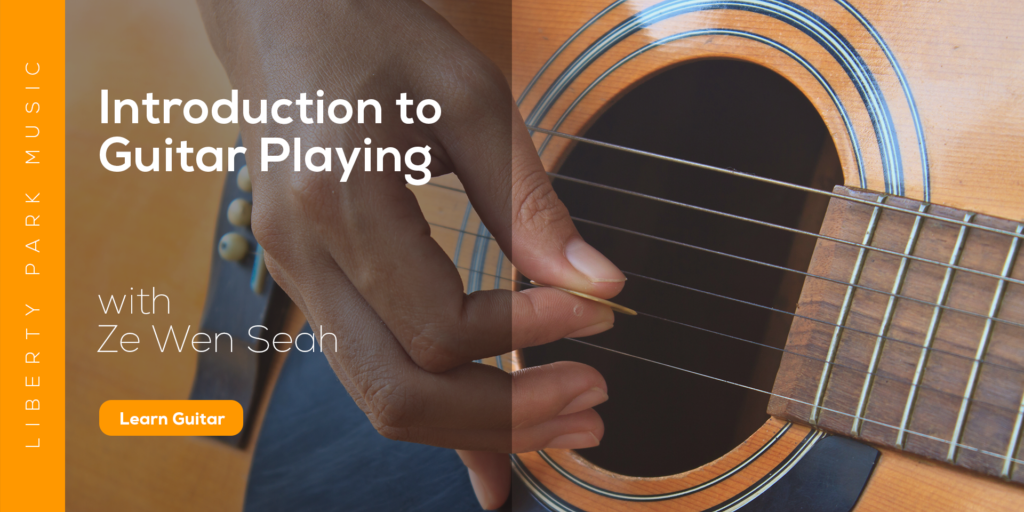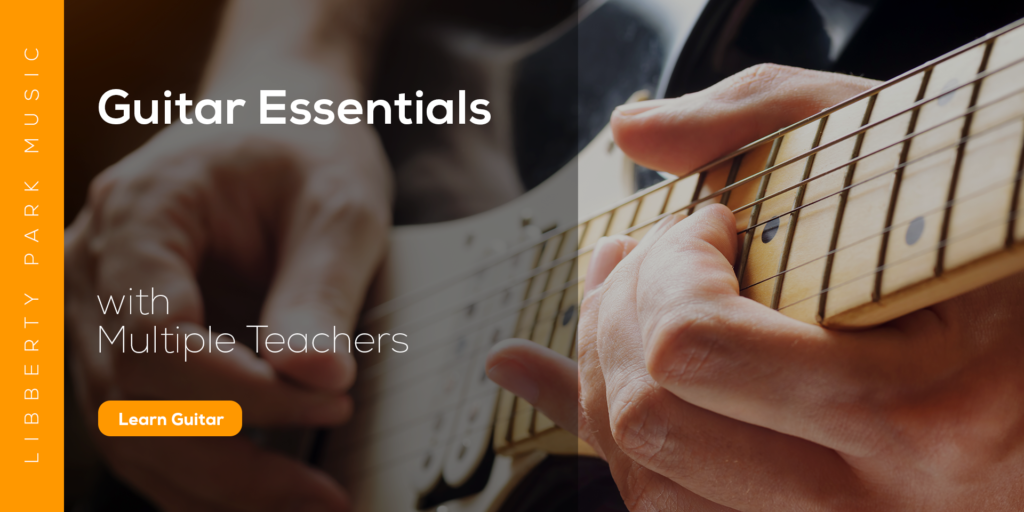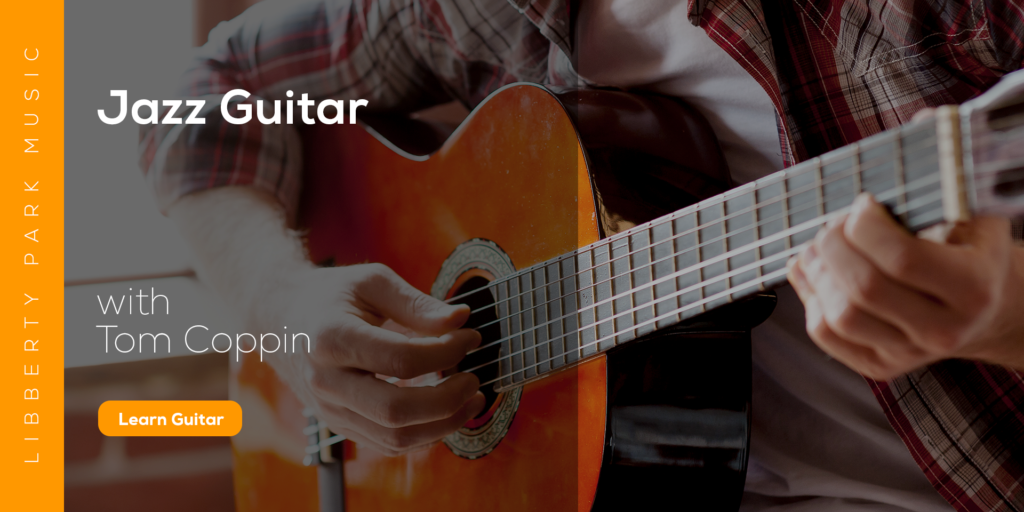
The reverb effect pedal is used to mimic natural reverb and to create a sense of depth and space in your guitar tone. Without a reverb effect, your guitar tone can often sound like it’s too up close and “dry,” which sounds unnatural as reverb exists in natural spaces.
Reverb, in essence, is the persistence and continuation of a sound after it is produced. That persistence of sound is created by sound waves reflecting off surfaces in a room. The eventual decay of the sound occurs when the sound waves get absorbed by objects in the environment, including things like walls, curtains, people, and furniture. Different objects have different sound reflecting and absorbing characteristics. For example, clapping your hands in a bathroom with ceramic tiles will sound very different from clapping your hands while under a blanket. The reason for that is the ceramic tiles in your bathroom reflect and absorb sound differently than a blanket.
These different characteristics are what reverb effect units try to emulate using digital algorithms, or less commonly these days, analog circuits.
Reverb is always used in modern recorded music as typically, recordings are made in “dry rooms” (rooms that have been designed to minimize sound reflection), only to have a reverb effect applied later. This technique of adding space to a sound after recording is a lot easier than actually finding a space that sounds good and recording your instrument in that space.
Reverb plays a vital role for many guitarists as it allows us to carve out a space in the sonic spectrum for our instrument. Having a completely dry guitar tone will often cause your guitar to stick out like a sore thumb in the mix. Many genres of music also rely heavily on using reverb to get a specific tone or ambient feel, making reverb an essential effect in many guitarists’ pedalboards.
However, before we get into a list of some of the most popular reverb pedals, let’s first discuss the most popular spaces, or rooms, that reverb pedals attempt to emulate.
Room: A room reverb typically tries to emulate the sound of a small room with parallel walls and a regular ceiling height (eight to nine feet high). Generally, actual physical rooms are designed with practical purposes in mind, mainly for shelter, instead of being designed to sound good. The result is a room with sonic “imperfections” such as fluttering reflections, standing waves (the build up of certain frequencies), and ringing. Try clapping your hand in your room right now. You may notice that the sonic reflections come back quickly, and they often have a “pinging” or “ringing” characteristic.
However, just because a room wasn’t designed to sound good, doesn’t mean it can’t. Rooms often have a unique sonic color to them, and using a room reverb on your instrument can give it an “intimate” vibe as it sounds like the instrument is being played in a small space. Due to the intimate vibe, room reverbs are commonly used in acoustic genres of music.
Hall: Hall reverbs are some of the most commonly used reverbs across different genres of music. I mentioned previously that a room reverb is modeled after a sonically “imperfect” room. In contrast, a hall reverb is modeled after a room that has been designed to sound great for music. For example, most concert halls around the world are designed with acoustics in mind, and frequently, just the design of the hall itself can cost millions as it takes a good understanding of math and physics to design such spaces.
Most concert halls are designed in a way where the sound can travel for a longer period of time, resulting in a longer decay of the reverb. This reverb can make your instrument sound really big and grand, which can be great for those burning rock solos.
Plate: A plate reverb emulates an early method of generating a reverb with a long decay without the use of a large room. This method relies on hanging a thin sheet of metal under tension in a room. A transducer is then used to direct audio into the plate, while contact microphones, usually two or more, are fixed to the surface of the plate to capture the reflection of sound. The resulting reverb sound is one that is often described as clean, bright, and long.
Thankfully, these days we no longer have to use actual plate reverb devices as digital reverb effects units have gotten to the point where they sound almost identical to the original plate reverbs. What’s even better is that it’s easier to tweak the reverb sound on these digital devices to get that perfect sound you hear in your head.
Plate reverbs are used across all genres of music as their clean sound allows them to blend with other instruments very well.
Spring: Spring reverbs are like a cheaper form of plate reverbs, and they are typically built into guitar amplifiers. Many Fender amps, including the Deluxe Reverb and Twin Reverb, are actually known for the sound of their spring reverbs. The way a spring reverb works is very similar to plate reverbs. A sound is projected into a spring coil, and the vibration of the spring is captured with contact microphones. In the case of amps with built-in spring reverbs, there is no need to capture the sound of the spring reverb with microphones, as you’re just adding the sound of a spring reverb into the overall sound coming out of the amp.
Spring reverbs are generally used on individual instruments, instead of groups of instruments or an entire mix, as it does have a very “twangy” characteristic. You can hear this iconic twangy tone in many rockabilly tunes.
Algorithmic/Ambiences: Before diving into the term “Algorithmic Reverb,” let’s be clear that all digital emulations of reverbs are considered algorithmic as they are digital emulations of the original analog device or environment.
A digital reverb effects unit that provides all the previously listed reverb types is essentially using digital processing and algorithms to emulate these spaces. However, due to the flexibility of digital effects, algorithmic reverbs can be expanded way beyond emulating your typical hall or room reverb. Enter ambience-type reverbs.
- These types of reverbs use digital processing to create really unique, and sometimes whacky, sounding reverbs.
- These types of reverbs are where digital reverb units really start to shine as the possibilities are limitless.
- One of my favorite ambience reverbs is known as the Shimmer reverb, and you can find an example of what that sounds like here.
Now that we’ve gone through some of the more popular types of reverbs, let’s check out six popular reverb pedals across different price ranges and sizes.
1. TC Electronic Hall Of Fame Reverb
Brand New: $149
Used: $75 - $100
Let’s begin with a standard, compact-sized pedal with really simple and intuitive controls. The Hall Of Fame is one of the most popular pedals out there thanks to its 10 really good sounding reverbs based on TC Electronic’s Classic Library of Effects. All of your typical reverb sounds are provided, as well as some additional interesting options.
On the face of the pedal, four knobs are provided:
- One called “fx level” that controls the volume of the effect
- Another knob that controls the decay of the reverb
- One that controls the tone (how dark or bright the sound is) of the reverb
- One that allows you to choose between the different reverb sounds.
One really cool addition that comes with TC Electronic pedals is the addition of TonePrint.
TonePrint is a technology that allows you to beam custom sounds into your guitar pedal, through the use of a smartphone app or your computer. The best thing about TonePrint is that the online user-submitted library gives you an unlimited number of great sounding reverbs. There are even some sounds created, or inspired, by your favorite artists.
Check out the following video to see how TonePrint works. It is pretty cool.
TC Electronic also makes a micro-sized version of the Hall Of Fame. It gives you the same sounds, but with fewer controls due to the smaller housing size.
Some of your favorite artists that have been seen using this pedal include Robben Ford, Steve Vai, and Joe Perry.
Buy here
2. Electro-Harmonix Holy Grail Nano
Brand New: $121
Used: $65 - $90
Here is another compact-sized reverb pedal that has even simpler controls than the Hall Of Fame. If you hate spending time tweaking your pedals, this will probably be a good fit for you. The fact that it can be found on the pedalboards of many professional musicians is a testament to the sound of the pedal, in spite of its simplicity.
There is only one knob labeled “Reverb” on this pedal that controls the over amount of reverb added to your sound. A toggle switch to the left of it allows you to select between three different reverb settings: Spring, Hall, and Flerb (reverb sound that has been flanged).
This pedal also comes in three other versions that vary in size and adjustable settings: Max, Neo, and Plus.
Josh Klinghoffer and Angel Olson have both been known to use a version of the Holy Grail pedal.
Buy here
3. Strymon BigSky Reverb
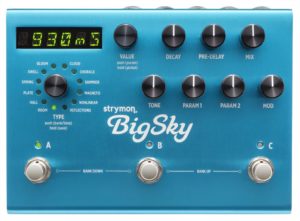
Brand New: $479
Used: $400 - $450
Strymon has made a name for itself in a relatively short amount of time thanks to their attention to tonal details and great sounding effects. The BigSky Reverb Pedal is no exception, and this pedal can be thought of as a granddaddy of all reverb pedals due to the number of built-in features, and the fact that it can get you sounds that were once thought only possible with rack-mounted units.
The BigSky comes with 12 sounds that can be tweaked specifically to your liking with five knobs that control:
- Decay
- Pre-delay (the time it takes for the first sound reflection to be audible)
- Mix
- Tone
- Mod (modulating filters on the sound)
- Two additional knobs that control sound-specific parameters
Three additional footswitches allow you to scroll between your saved presets. Up to 300 presets can be stored in over 100 banks. All your presets can be edited through Strymon’s Preset Librarian computer software.
The price and larger chassis-size may be a big turn off for many of you, but the sounds that you can get from the BigSky are truly incredible.
Artists that use this pedal include Tosin Abasi, Brad Delson, and Jonny Buckland.
Buy here
4. Boss RV-6 Reverb
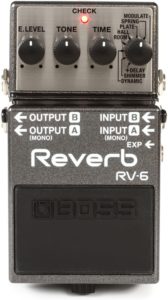
Brand New: $150
Used: $95 - $115
Here is an updated version of a classic, easy-to-use reverb pedal. The RV-6 comes in Boss’s familiar sturdy and compact housing. The controls are really simple too, as with most of Boss’s stompboxes.
Three of the four knobs allow you to adjust the effect’s level, tone, and time (decay). The last knob allows you to choose between seven different reverb sounds, with an additional eighth sound that is a delay effect. A neat little feature with this pedal is that it has an input for an expression pedal. Connecting an expression pedal will allow you to adjust the volume of the reverb with your foot, so this allows you to increase or decrease the reverb while still playing the guitar.
Popular artists that use this pedal include Brynjar Leifsson, KT Tunstall, and Zach Abels.
Buy here
5. Catalinbread Topanga Spring Reverb

Brand New: $195
Used: $150 - $180
Catalinbread’s Topanga has a single goal, and that is to get a Fender 6G15 spring reverb unit into a stompbox. The Fender 6G15 is a spring reverb unit filled with tubes, capacitors, springs, and a bunch of other components that work together to get the highly iconic sound of a great spring reverb unit.
The Topanga Spring Reverb actually does a pretty decent job of emulating that sound with just a digital processor and a few electrical components.
Similar to the Fender 6G15, the Topanga has four knobs that control mix (between effect and dry signal), dwell (decay), tone, and finally, a volume knob that boosts the overall output volume in case some volume was lost when cranking up the mix knob.
This small and simple unit really aims at only doing one thing really well, and that’s to create a vintage style spring reverb sound--and it sounds pretty convincing.
Popular artists that use this pedal include Joe Perry and Noel Gallagher.
Buy here
6. EarthQuaker Avalanche Run
Brand New: $299
Used: $200 - $245
Here is a pedal that’s really more of a 2-in-1 effects unit. Within this relatively compact pedal lies a great sounding reverb as well as an excellent delay sound. Many people see reverb and delay having a relationship akin to peanut butter and jelly; on their own, they sound pretty good, but when joined together, they complement each other so well and it really takes things to another level.
A pedal like this will be great for those of you looking to save space on your pedalboard, or if you’re just looking to simplify your ambient effects down to a single pedal.
The Avalanche Run is also quite simple to use, but it packs many additional advanced features. On its face, there are four knobs on the upper row titled Time, Repeat, Tone, and Mix that control the delay portion of the pedal. If you’re wondering how these controls affect the delay sound, feel free to check out our article on delay pedals!
- The two black knobs on the bottom row titled Decay and Mix are controls for the reverb portion of the pedal.
- Below those two knobs lies a three-way switch that allows you to switch between Normal, Reverse, and Swell functions.
- Normal mode causes the pedal to behave like a regular delay and reverb combo pedal, Reverse mode causes the delays to play in reverse while the reverb continues as if in Normal mode, and Swell mode causes the Avalanche Run to react to your picking dynamics in a manner similar to rolling your volume knob on your guitar up and down.
- This creates a really nice ambient swell effect that will be great in post-rock, worship, electronic, pop, and even rock music.
An expression pedal can also be attached to the pedal, and what parameter the expression pedal adjusts can be selected via the white knob labeled EXP. The other white knob labeled Ratio controls the subdivision of delayed notes for the delay section of the pedal. Of course, a tap-tempo footswitch is provided too.
Popular artists that use this pedal include Isaac Brock, Peter Mengede, and Brian Fallon.
Buy here
Final note
As you can see, reverb pedals come in all shapes and sizes, and they all have a variety of features too. Which reverb unit you will settle on really comes down to your needs and the genres of music that you’ll be playing. Many amps already come with built-in reverb effects, and for many genres, that may be all you really need. Afterall, for most styles of music, reverb is only needed to create a subtle feel of depth and space in your guitar’s tone. Some genres, however, rely heavily on using ambient sounds as part of the music, and if that’s the case for the kind of music you’d like to play, then you’ll definitely want to look at something with more options.
Some of you may be wondering, “How do I know if my favorite genre of music requires a reverb pedal?” All you really have to do is listen to the guitar parts on your favorite tracks and it’ll become clear whether you’ll need a subtle and simple reverb effect, or something a little more complex.
One last thing about reverb is that it’s often easy to go overboard with the level of the effect, so as one old studio engineer once told me, a good way to dial in reverb (for most genres) is to put in just enough so that you can barely hear it, then turn it down just a little bit more and you’ll be good to go.
Reverb is often something that is felt rather than heard, meaning that you won’t notice the effect until you turn it off completely. That’s generally a good rule of thumb when it comes to dialing in reverb and delays. However, feel free to break all the rules when dealing with your personal tone.
These are some of the reverb pedals that I’ve found to be interesting over the years. Are there any that you think should be on this list too? Feel free to let us know in the comments!


